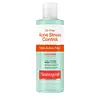What's inside
What's inside
 Key Ingredients
Key Ingredients

 Benefits
Benefits

 Concerns
Concerns

 Ingredients Side-by-side
Ingredients Side-by-side

Salicylic Acid
MaskingWater
Skin ConditioningAlcohol Denat.
AntimicrobialButylene Glycol
HumectantPPG-5-Ceteth-20
EmulsifyingC12-15 Alkyl Lactate
EmollientParfum
MaskingSodium Citrate
BufferingCocamidopropyl Pg-Dimonium Chloride Phosphate
PEG/PPG-20/6 Dimethicone
EmulsifyingSodium Hydroxide
BufferingBenzalkonium Chloride
AntimicrobialCetyl Lactate
EmollientSodium Benzotriazolyl Butylphenol Sulfonate
UV AbsorberDisodium EDTA
Propylene Glycol
HumectantCucumis Sativus Fruit Extract
EmollientCamellia Oleifera Leaf Extract
AstringentBlue 1 Lake
Cosmetic ColorantCamellia Sinensis Leaf Extract
AntimicrobialCI 19140
Cosmetic ColorantSalicylic Acid, Water, Alcohol Denat., Butylene Glycol, PPG-5-Ceteth-20, C12-15 Alkyl Lactate, Parfum, Sodium Citrate, Cocamidopropyl Pg-Dimonium Chloride Phosphate, PEG/PPG-20/6 Dimethicone, Sodium Hydroxide, Benzalkonium Chloride, Cetyl Lactate, Sodium Benzotriazolyl Butylphenol Sulfonate, Disodium EDTA, Propylene Glycol, Cucumis Sativus Fruit Extract, Camellia Oleifera Leaf Extract, Blue 1 Lake, Camellia Sinensis Leaf Extract, CI 19140
Salicylic Acid
MaskingWater
Skin ConditioningAlcohol Denat.
AntimicrobialPropanediol
SolventGlycolic Acid
BufferingSodium Hydroxide
BufferingCapryloyl Glycine
CleansingPhenoxyethanol
PreservativeBenzyl Alcohol
PerfumingPPG-26-Buteth-26
Skin ConditioningPEG-40 Hydrogenated Castor Oil
EmulsifyingMenthol
MaskingTremella Fuciformis Polysaccharide
Emulsion StabilisingButylene Glycol
HumectantOphiopogon Japonicus Root Extract
Skin ConditioningScutellaria Baicalensis Root Extract
AstringentSalicylic Acid, Water, Alcohol Denat., Propanediol, Glycolic Acid, Sodium Hydroxide, Capryloyl Glycine, Phenoxyethanol, Benzyl Alcohol, PPG-26-Buteth-26, PEG-40 Hydrogenated Castor Oil, Menthol, Tremella Fuciformis Polysaccharide, Butylene Glycol, Ophiopogon Japonicus Root Extract, Scutellaria Baicalensis Root Extract
 Reviews
Reviews

Ingredients Explained
These ingredients are found in both products.
Ingredients higher up in an ingredient list are typically present in a larger amount.
Alcohol Denat. is an alcohol with a denaturant property. It is created by mixing ethanol with other additives.
This ingredient gets a bad rep because it is irritating and drying - mostly due to its astringent property. Astringents draw out natural oils in tissue, constricting pores and leaving your skin dried out.
However, alcohol denat. is not all that bad.
Due to its low molecular weight, alcohol denat. tends to evaporate quickly. One study on pig skin found half of applied alcohol evaporated in 10 seconds and less than 3% stayed on skin.
This also helps other ingredients become better absorbed upon application.
Studies are conflicted about whether this ingredient causes skin dehydration. One study from 2005 found adding emollients to propanol-based sanitizer decreased skin dryness and irritation. Another study found irritation only occurs if your skin is already damaged.
Small amounts of alcohol are generally tolerated by oily skin or people who live in humid environments.
The rule of thumb is if this alcohol is near the end of an ingredients list, it will probably not affect your skin much.
Also...
This ingredient has antimicrobial and solvent properties.
The antimicrobial property helps preserve products and increase their shelf life. As a solvent, it helps dissolve other ingredients.
Other types of astringent alcohols include:
Learn more about Alcohol Denat.Butylene Glycol (or BG) is used within cosmetic products for a few different reasons:
Overall, Butylene Glycol is a safe and well-rounded ingredient that works well with other ingredients.
Though this ingredient works well with most skin types, some people with sensitive skin may experience a reaction such as allergic rashes, closed comedones, or itchiness.
Learn more about Butylene GlycolSalicylic Acid (also known as beta hydroxy acid or BHA) is a well-known ingredient for treating skin that struggles with acne and clogged pores. It exfoliates both the skin's surface and deep within the pores to help clear out buildup, control oil, and reduce inflammation.
Unlike AHAs (alpha hydroxy acids), salicylic acid is oil-soluble. This allows it to penetrate into pores which makes it especially effective for treating blackheads and preventing future breakouts.
Salicylic acid is also known for its soothing properties. It has a similar structure to aspirin and can calm inflamed or irritated skin, making it a good option for acne-prone skin that is also sensitive.
Concentrations of 0.5-2% are recognized by the U.S. FDA as an over-the-counter topical acne product.
It can cause irritation and/or dryness if one's skin already has a compromised moisture barrier, so it's best to focus on repairing that before introducing this ingredient into your routine.
While salicylic acid does not increase sun sensitivity, it’s still important to wear sunscreen daily to protect your skin.
If you are looking for the ingredient called BHA or Butylated Hydroxyanisole, click here.
Learn more about Salicylic AcidSodium Hydroxide is also known as lye or caustic soda. It is used to adjust the pH of products; many ingredients require a specific pH to be effective.
In small amounts, sodium hydroxide is considered safe to use. However, large amounts may cause chemical burns due to its high alkaline.
Your skin has a natural pH and acid mantle. This acid mantle helps prevent harmful bacteria from breaking through. The acid mantle also helps keep your skin hydrated.
"Alkaline" refers to a high pH level. A low pH level would be considered acidic.
Learn more about Sodium HydroxideWater. It's the most common cosmetic ingredient of all. You'll usually see it at the top of ingredient lists, meaning that it makes up the largest part of the product.
So why is it so popular? Water most often acts as a solvent - this means that it helps dissolve other ingredients into the formulation.
You'll also recognize water as that liquid we all need to stay alive. If you see this, drink a glass of water. Stay hydrated!
Learn more about Water